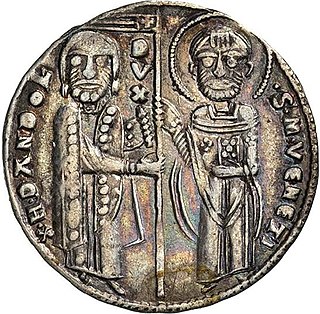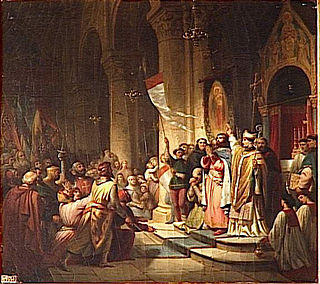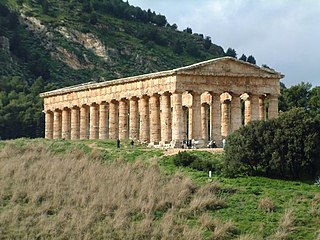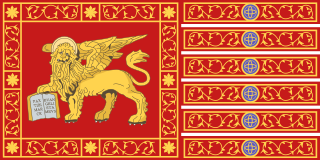Related Research Articles

Enrico Dandolo was the doge of Venice from 1192 until his death. He is remembered for his avowed piety, longevity, and shrewdness, and his role in the Fourth Crusade and the Sack of Constantinople. Dandolo died in 1205 in Constantinople and was buried at the Hagia Sophia.

Tancred was King of Sicily from 1189 to 1194. He was born in Lecce an illegitimate son of Roger III, Duke of Apulia by his mistress Emma, a daughter of Achard II, Count of Lecce. He inherited the title "Count of Lecce" from his grandfather and is consequently often referred to as Tancred of Lecce. Due to his short stature and unhandsome visage, he was mocked by his critics as "The Monkey King".

Constance I was reigning Queen of Sicily from 1194–98, jointly with her spouse from 1194 to 1197, and with her infant son Frederick II, Holy Roman Emperor, in 1198. She is particularly notable for her actions against her own family, the Norman kings of Sicily; she played an important role in the end of the Hauteville presence in Sicily. She was also Holy Roman Empress and later Dowager by marriage to Henry VI, Holy Roman Emperor.

Boniface I, usually known as Boniface of Montferrat, was the ninth Marquis of Montferrat, a leader of the Fourth Crusade (1201–04) and the king of Thessalonica.

The Republic of Genoa was a medieval and early modern maritime republic from the years 1099 to 1797 in Liguria on the northwestern Italian coast. During the Late Middle Ages, it was a major commercial power in both the Mediterranean and Black Sea. Between the 16th and 17th centuries, it was one of the major financial centers in Europe.
Marco Sanudo was the creator and first Duke of the Duchy of the Archipelago, in Italian: "Duca del Mare Egeo e Re di Candia", Barone delle Isole di Nasso, Pario, Milo, Marine ed Andri, duchy granted by the Republic of Venice to him and all his descendants, after the Fourth Crusade his lineage became named Sanudo de Candia.

The Kingdom of Sicily was a state that existed in Sicily and the south of the Italian Peninsula plus, for a time, in Northern Africa from its founding by Roger II of Sicily in 1130 until 1816. It was a successor state of the County of Sicily, which had been founded in 1071 during the Norman conquest of the southern peninsula. The island was divided into three regions: Val di Mazara, Val Demone and Val di Noto.

Margaritus of Brindisi, called "the new Neptune", was the last great ammiratus ammiratorum of the Kingdom of Sicily. Following in the footsteps of Christodulus, George of Antioch, and Maio of Bari, Margaritus commanded the kingdom's fleets during the reigns of William II (1166–1189) and Tancred (1189–1194). He probably began as a Greek pirate and gradually rose to the rank of privateer before becoming a permanent admiral of the navy. In 1185, he became the first count palatine of Cephalonia and Zakynthos. In 1192, he became the first Count of Malta. He also held the titles of Prince of Taranto and Duke of Durazzo.

The history of Sicily has been influenced by numerous ethnic groups. It has seen Sicily controlled by powers, including Phoenician and Carthaginian, Greek, Roman, Vandal and Ostrogoth, Byzantine, Arab, Norman, Aragonese, Spanish, Austrians, British, but also experiencing important periods of independence, as under the indigenous Sicanians, Elymians, Sicels, the Greek-Siceliotes, and later as County of Sicily, and Kingdom of Sicily. The Kingdom was founded in 1130 by Roger II, belonging to the Siculo-Norman family of Hauteville. During this period, Sicily was prosperous and politically powerful, becoming one of the wealthiest states in all of Europe. As a result of the dynastic succession, the Kingdom passed into the hands of the Hohenstaufen. At the end of the 13th century, with the War of the Sicilian Vespers between the crowns of Anjou and Aragon, the island passed to the latter. In the following centuries the Kingdom entered into the personal union with the Spaniard and Bourbon crowns, while preserving effective independence until 1816. Sicily was merged with the Kingdom of Italy in 1861. Although today an Autonomous Region, with special statute, of the Republic of Italy, it has its own distinct culture.
The County of Malta was a feudal lordship of the Kingdom of Sicily, relating to the islands of Malta and Gozo. Malta was essentially a fief within the kingdom, with the title given by Tancred of Sicily the Norman king of Sicily to Margaritus of Brindisi in 1192 who earned acclaim as the Grand Admiral of Sicily. Afterwards the fiefdom was passed from nobleman to nobleman remaining as a family possession in a few instances. It was used mainly as a bargaining tool in Sicilian politics leading to a rather turbulent history. The fiefdom was elevated to a Marquisate in 1392 and either title was no longer used after 1429.

The Venetian–Genoese Wars were four conflicts between the Republic of Venice and the Republic of Genoa which took place between 1256 and 1381. Each were resolved almost entirely through naval clashes and connected to each other by interludes during which episodes of piracy and violence between the two Italian trading communities in the Mediterranean Sea and the Black Sea were commonplace, in a "cold war" climate.

Jacopo Tiepolo, also known as Giacomo Tiepolo, was Doge of Venice from 1229 to 1249. He had previously served as the first Venetian Duke of Crete, and two terms as Podestà of Constantinople, twice as governor of Treviso, and three times as ambassador to the Holy See. His dogate was marked by major domestic reforms, including the codification of civil law and the establishment of the Venetian Senate, but also against a mounting conflict with Emperor Frederick II, which broke into open war from 1237 to 1245.

Giovanni Dandolo was the 48th Doge of Venice, elected late in his life on 31 March 1280. He died on 2 November 1289. During his reign, the first Venetian gold ducat was introduced into circulation.
Guglielmo Grasso, sometimes anglicized William Grassus, was a Genoese merchant, pirate and admiral.

Henry VI, a member of the Hohenstaufen dynasty, was King of Germany from 1169 and Holy Roman Emperor from 1191 until his death. From 1194 he was also King of Sicily.
This article presents a detailed timeline of the history of the Republic of Venice from its legendary foundation to its collapse under the efforts of Napoleon.

The Realm or Kingdom of Candia or Duchy of Candia was the official name of Crete during the island's period as an overseas colony of the Republic of Venice, from the initial Venetian conquest in 1205–1212 to its fall to the Ottoman Empire during the Cretan War (1645–1669). The island was at the time and up to the early modern era commonly known as Candia after its capital, Candia or Chandax. In modern Greek historiography, the period is known as the Venetocracy.
Alamanno da Costa was a Genoese admiral. He became the count of Syracuse in the Kingdom of Sicily, and led naval expeditions throughout the eastern Mediterranean. He was an important figure in Genoa's longstanding conflict with Pisa and in the origin of its conflict with Venice. The historian Ernst Kantorowicz called him a "famous prince of pirates".

Ulrich II von Treven was Patriarch of Aquileia in northern Italy from 1161 to 1181. He supported Frederick I, Holy Roman Emperor, (1122–1190) in his unsuccessful struggle for supremacy over the northern Italian states and the papacy. He was also involved in a dispute over jurisdiction with the Patriarch of Grado where he was ultimately successful.
References
- David Abulafia. Henry count of Malta and his Mediterranean activities: 1203-1230, in Italy, Sicily and the Mediterranean, 1100-1400 (1987)
- Basso, Enrico (2015). "Pescatore, Enrico". Dizionario Biografico degli Italiani, Volume 82: Pazzi–Pia (in Italian). Rome: Istituto dell'Enciclopedia Italiana. ISBN 978-8-81200032-6.